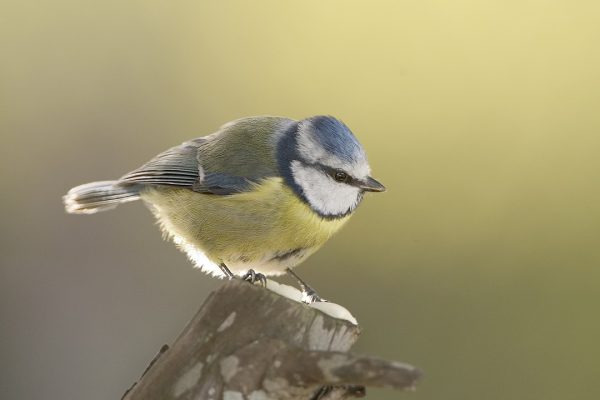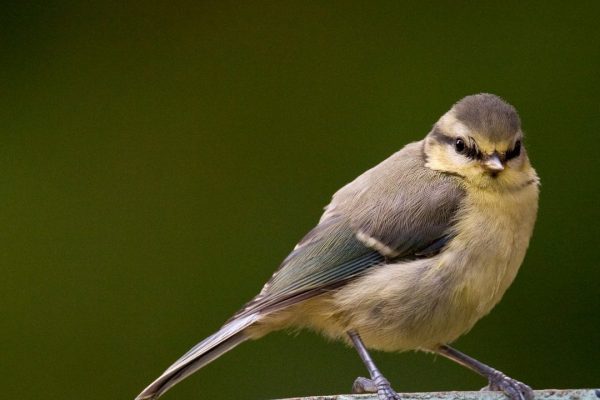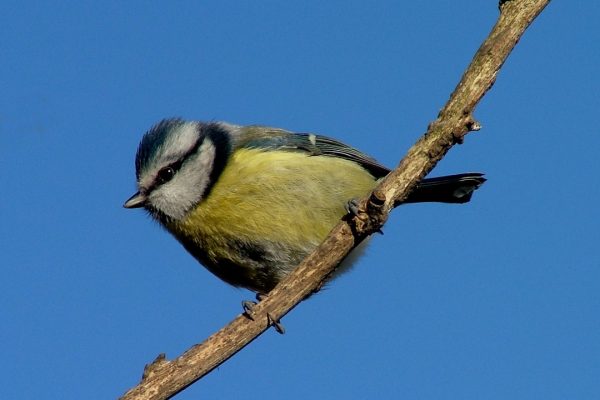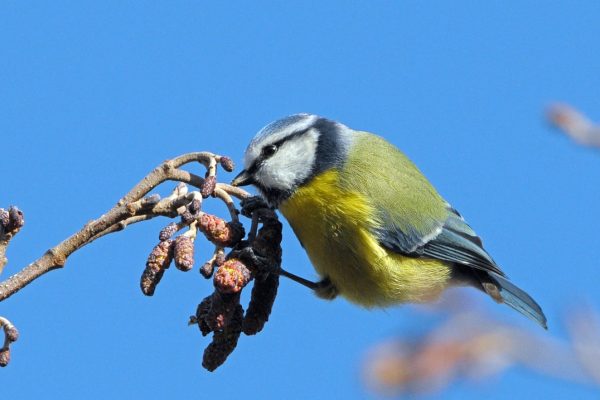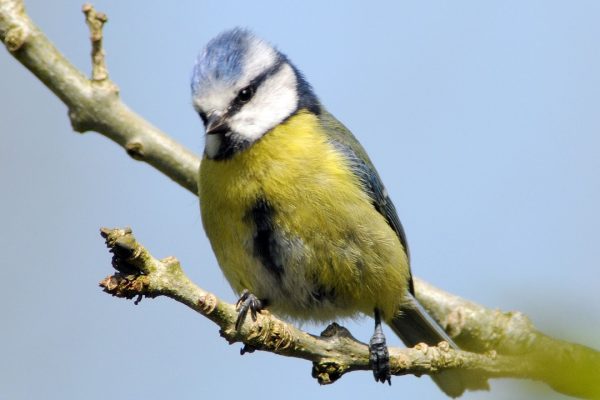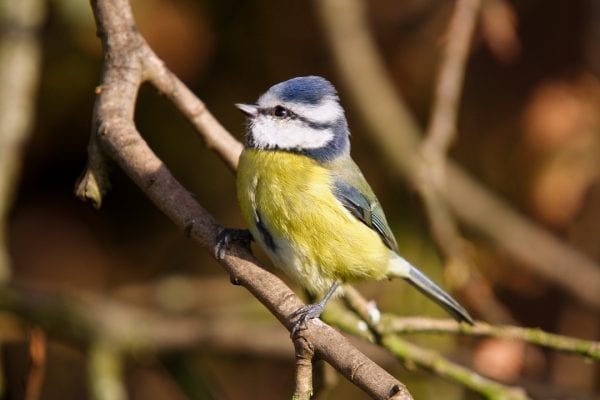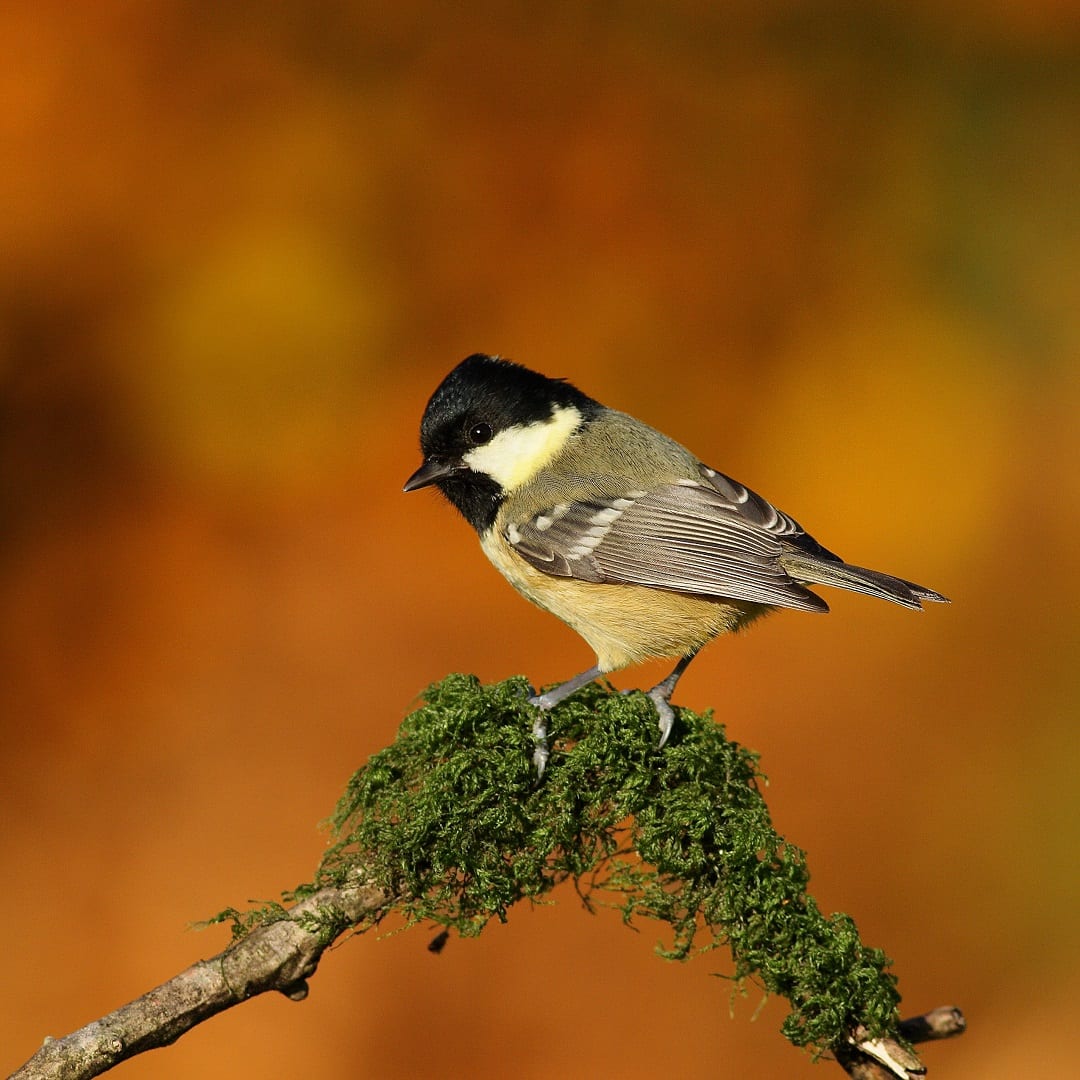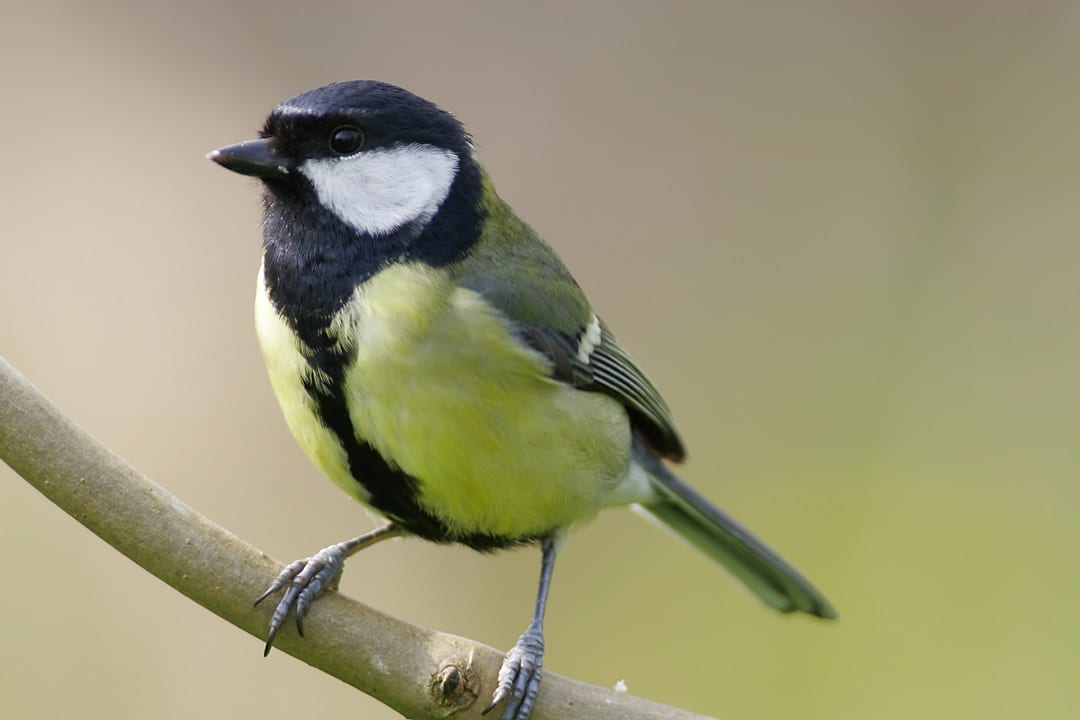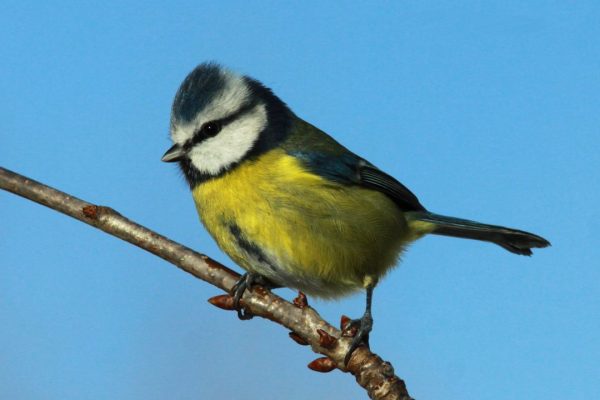
Blue Tit
| Irish Name: | Meantán gorm |
| Scientific name: | Cyanistes caeruleus |
| Bird Family: | Tits |
green
Conservation status
Conservation status
Status
Common resident throughout Ireland. One of Ireland's top 20 most widespread garden birds.
Identification
A colourful, noisy, active little bird, commonly seen in gardens, especially at nut feeders and will use nestboxes. Bright blue crown, nape collar, wings and tail and yellow underside. The white cheeks are bordered by a dark blue line - the line through the eye is separated from the blue cap by a white band - all producing a distinctive head pattern. Bill is short and stubby, legs bluish-grey. Very acrobatic, often hangs upside-down on branches pecking at buds or foraging for insects. Regular visitor to peanut feeders and will use nestboxes. Occurs in woodland, farmland, gardens etc. Usually seen in small groups in winter and will team up with other tit species, Treecreepers and Goldcrests to form roving bands.
Voice
Song a clear, quite high-pitched "tsee-hee-he-hee…". Call a series of scolding chuckles, also many short twitters
Diet
Mainly small insects, but also seeds and will readily use peanut feeder and take scraps from bird table.
Breeding
Breeds throughout Ireland - prefers broad-leaved woodland, but also in farmland, parks and gardens. Nests in cavity in tree or wall. Occasionally chooses an unusual site such as a pipe or letterbox, but will readily use nestboxes.
Wintering
Largely resident.
Monitored by
Blog posts about this bird
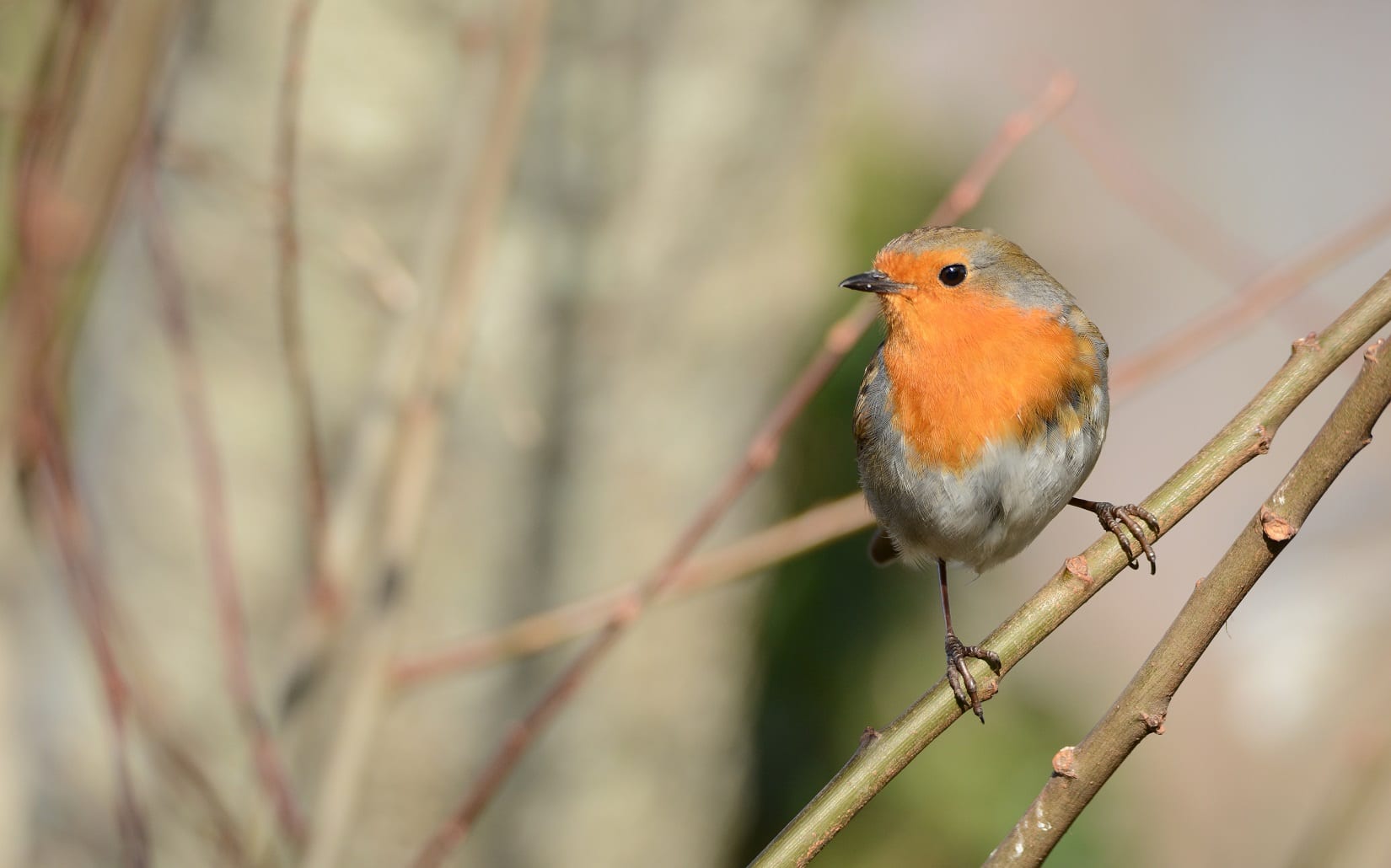
BirdWatch Ireland Calls for Public Participation in Critical Bird Survey Starting November 25th
BirdWatch Ireland is calling on people across the country to help monitor the health of the country’s bird populations by counting the birds visiting their garden over the winter.
Ireland’s longest-running and most popular citizen science survey, the Irish Garden Bird Survey, will commence on Monday, November 25th and run until the end of February. Taking part is free and simple, yet impactful, as all participants contribute to a crucial body of data that will help to inform monitoring and research into bird populations and environmental change.
Last year’s survey, which saw over 1,600 households across the country participating, revealed the Robin as Ireland’s top garden bird once again, present in 96% of gardens. Blackbird and Blue Tit followed in second and third place, occurring in 94% and 91% of gardens respectively. However, all three species appeared in fewer gardens than at any point in the last thirty years due to the mild winter weather conditions, which reduced birds’ need for garden feeders.
Of the top 30 species seen in Irish gardens last winter, 25 occurred in a lower percentage of gardens than the previous winter.






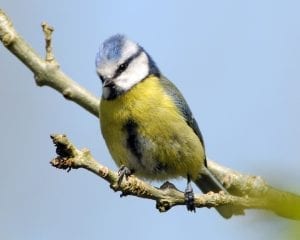
Blue Tit. Photo: Michael Finn.
“We often get emails from people early in the winter wondering where their garden birds are, but last winter people all over the country were commenting on how quiet their gardens were,” said Brian Burke, coordinator of the Irish Garden Bird Survey. “This week we’re seeing very cold conditions across the country, and that’s definitely driving more birds into gardens at the moment, so it’ll be interesting to see what the coming weeks bring. The more people who do the survey, the more we can learn about these sorts of links between climate, birds and our environment.”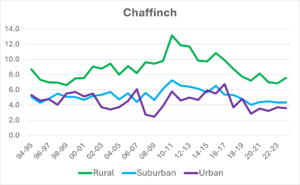
Average Chaffinch numbers per garden show that they occur in greater flock sizes in rural gardens than urban or suburban ones.
Other species including Chaffinch, Coal Tit and Jackdaw were at their lowest occurrence in 30 years, while Song Thrush and Pied Wagtail showed a huge drop of 12% since the previous winter. One species, the Siskin, bucked this trend, occurring in 41% of gardens compared to 26% the previous year. This is largely due to their reliance on alder, birch, spruce and pine tree seeds as a food source. Considering the cyclical nature of seed supply, such peaks in Siskin numbers are expected every three years or so. They tend to occur in relatively few gardens in December, increasing in January, and becoming much more common throughout February. Similar mid-winter increases were seen with Redpoll and Long-tailed Tit, amongst other species.
Long-tailed Tit occurrence in gardens increased greatly after the first week of January (Week 6) and remained high until the end of February.
While it was anticipated that Greenfinch would experience declines due to the impact of the deadly Trichomoniasis condition on the species, it was one of very few species with a stable trend and virtually no change from the previous winter. Greenfinch have occurred in 47-48% of gardens in each of the last three winters, which may indicate that their rapid declines have stabilised. The species is currently on the Amber list as a species of medium-level conservation concern. As usual, there are clear differences in the birds visiting gardens across the country. Notable differences in Ulster include Blackbird being the most widespread species, Goldfinch not featuring in the top 10 (12th), and it being the only province with either Jackdaw or Song Thrush in the top 10. Out west in Connaught, Coal Tit and Wren came in 9th and Starling only in 13th. Leinster was once again the only region to feature Woodpigeon in the top 10. The top 10 in Munster was very similar to the national rankings, though notably, the Rook was the 11th most common species there, much higher than elsewhere. As a conservation charity with a small team, BirdWatch Ireland is reliant on members of the public to help gather vital data about Ireland’s many bird species. In addition to contributing valuable information, participants often enhance their bird identification skills and gain insights into the journeys these birds undertake. Indeed, some of last year’s participants reported ringed birds that visited their gardens including a Goldfinch discovered in Tipperary that was originally ringed in Maine-et-Loire in France, and a Redwing found in Carlow that was ringed at Sandwich Bay Bird Observatory in Kent, England.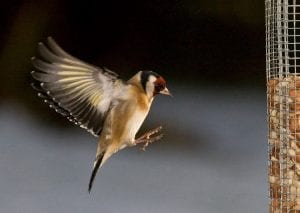
Goldfinch. Photo: Kevin Murphy.
Taking part in the Irish Garden Bird Survey is a win-win for science and for individual participants and this year, BirdWatch Ireland hopes to encourage even more people to take part. All you need to get involved is a little bit of time each week to watch your garden birds, access to a garden or any outdoor space such as a community garden or school grounds, and a sense of curiosity. The Irish Garden Bird Survey is once again sponsored by Ballymaloe, whose support in recent years has helped ensure the survey has gone from strength to strength, improving monitoring at national level and allowing for greater focus on conservation issues facing individual species. Commenting on their ongoing support for the survey, a Ballymaloe spokesperson said: "United in our commitment to the environment and inspired by the legacy of our forefather, Ivan Allen, Ballymaloe businesses as a group proudly sponsor BirdWatch Ireland's annual Irish Garden Bird Survey. Mr Ivan Allen, the husband of Myrtle Allen and a devoted lover of birdlife, cherished the natural habitat around Ballymaloe House, and practised sustainable farming way ahead of his time. In his memory, our collective support for the Irish Bird Survey reflects our ongoing celebration of Mr Allen's passion for birdlife and commitment to conservation. Together Ballymaloe House Hotel, the Ballymaloe Cookery School and Ballymaloe Foods are honoured to contribute towards supporting the preservation of Irish birdlife via BirdWatch Ireland's important national Irish Garden Bird Survey initiative in his name. We encourage as many households as possible to get involved, every entry helps BirdWatch Ireland protect birdlife on the island of Ireland." To learn more about the survey and to get involved, see here: https://birdwatchireland.ie/our-work/surveys-research/research-surveys/irish-garden-bird-survey/.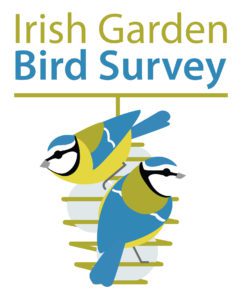

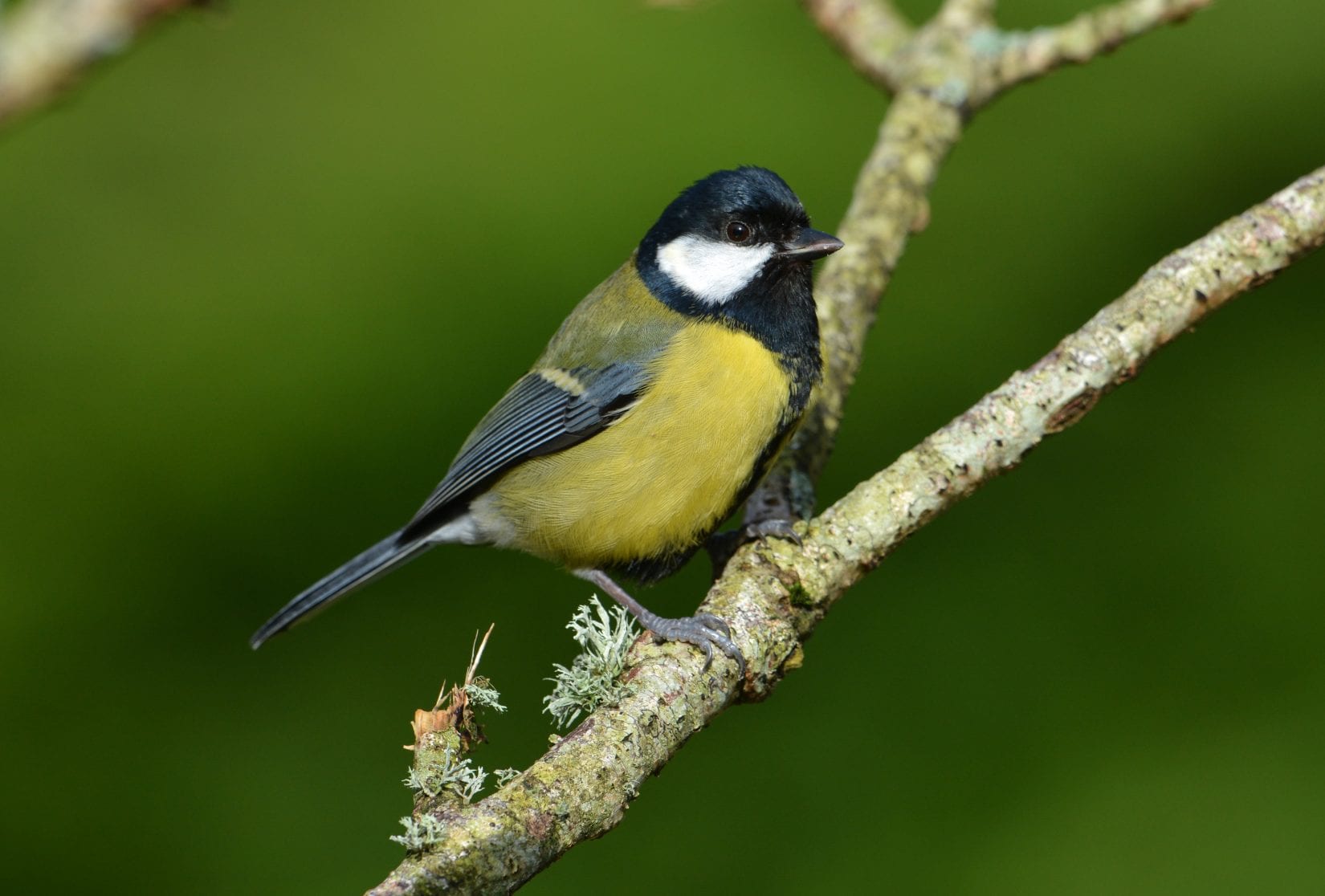
Flight of the garden birds – understanding the summer disappearance of your feathered friends
Has your garden grown quieter in recent weeks? Don’t worry. Your beloved feathered friends probably haven’t abandoned your garden for a better peanut feeder, nor is it likely that anything is wrong. In fact, it is completely normal for birds to disappear for a while in mid-summer. Here are some reasons why.
Protective parents
From late spring to the middle of the summer (and longer for some species) birds are thinking about courting a mate, building a nest, incubating a clutch of eggs and all going well, spending several weeks frantically trying to feed a hungry brood. All of this activity centres around a territory and later a nest. The adults can’t travel far from it, or they could lose their territory or mate to a rival, a predator could find the eggs, or the chicks could go hungry! This is the reason you won’t get flocks of anything in your garden in summer, or at best you might get a couple of pairs of Blue Tits or Chaffinches visiting your garden – they’re all spread out and can’t move far until the chicks are raised.

Blue Tit. Photo: Brian Burke.
Food glorious food In summertime, the natural world is brimming with foodstuffs. With insects, seeds, fruit and more in abundance, birds are simply spoiled for choice! For this reason, they aren’t as reliant on bird feeders as they are in the winter. People often ask us whether they should leave bird feeders up in the summer, when birds have plenty of natural food available to them. While it isn’t as vital to do so as in winter, there is no harm in leaving the feeders up throughout the year. In fact, it is likely to be much appreciated by the busy parents! Adult birds are required to feed both themselves and their chicks during the summer. Supplying them with food in your garden allows them easy access to food for themselves, giving them more time and energy to search for more protein-rich food for their chicks. It’s best to avoid fat/suet-based products during the summer months, but do put out mealworms, peanuts, nyjer seeds and sunflower seeds. Of course, our guidance around bird feeder hygiene applies all year round and research indicates that late summer and autumn is the peak time for infections such as trichomonosis to spread amongst wild bird populations. To prevent the transmission of bacteria, parasites and other infections, be sure to clean all feeders and water dishes every 1-2 weeks with a veterinary disinfectant or mild bleach (5%) solution. Give the feeders a good scrub, a thorough rinse and allow them to air dry completely before using them again. It’s also worthwhile to switch the location of your feeders from time to time, so that there isn’t a build of droppings in any one location, and to spread your feeders around the garden so birds aren’t all coming together at one location. Read more about disease prevention and bird feeder hygiene here.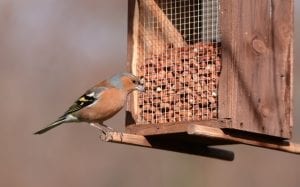
Chaffinch. Photo: Brian Burke.
Recovery mode The breeding season is an extremely taxing period in the life of a small bird and by the end of it the birds, and indeed their feathers, are worn out! If you take a close look at some adult birds at this time of year you’ll often see dull colours compared to the vivid pigments of a few months ago, and their feathers are by now very worn and tatty. Once their chicks have fledged, many species take this opportunity to freshen things up, moult their feathers and head into the latter half of the year in good condition so they can take whatever the winter throws at them. Adult birds of most species will replace every single feather over the course of a couple of weeks. This requires a lot of energy, and the temporary loss of feathers leaves them less agile and more vulnerable to predators. Because of this, birds will keep a low profile until the moulting process is complete. They’re still there, even if you can’t see them. When will the birds return to my garden? As the nesting and moulting periods vary depending on the species, it is difficult to say for sure when birds will arrive back to your garden. It will also depend on factors such as weather and natural food availability, and you might find you get some busy weeks and some quiet weeks with a high degree of unpredictability between now and November. However, be sure to keep those eyes peeled and, if you’re using them, those feeders at least half-filled as it is likely you’ll have some visitors checking in on them from time to time.
